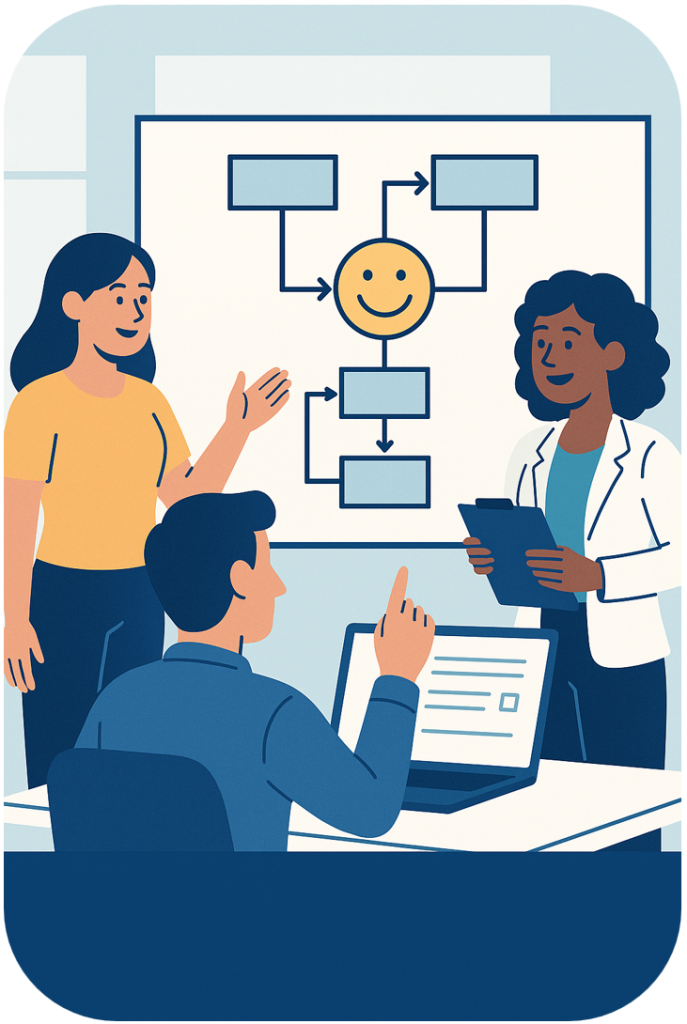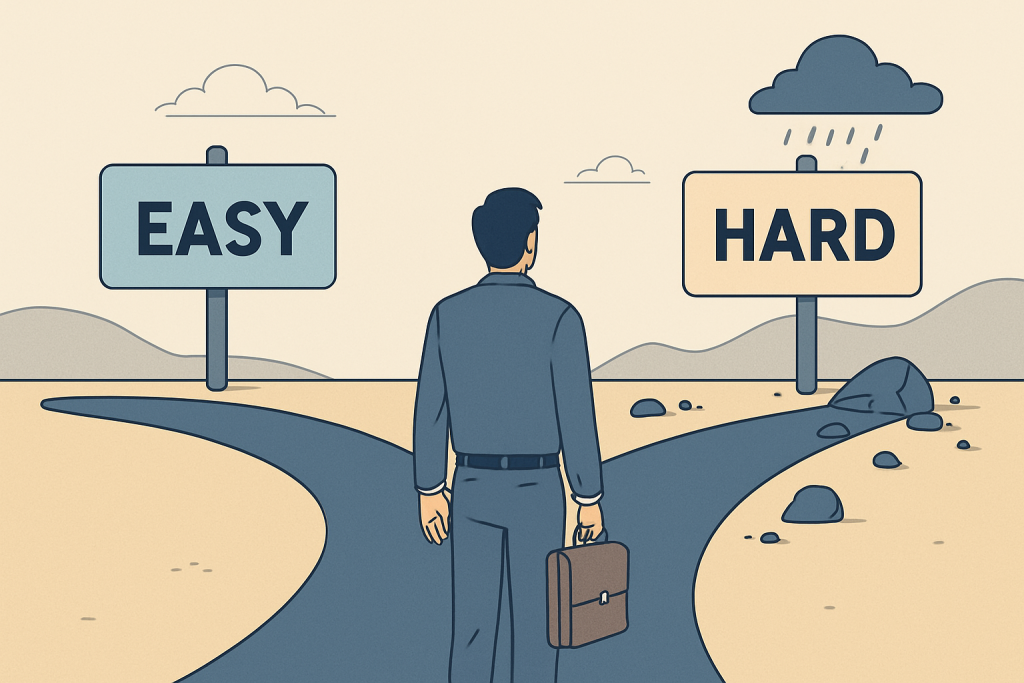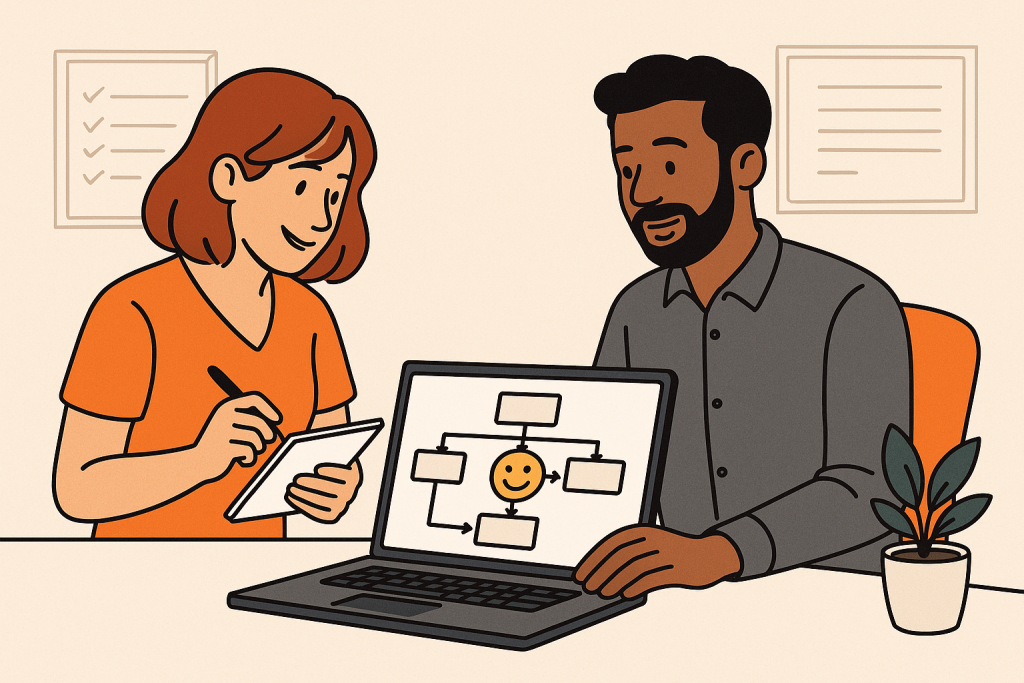Turn the Workplace Happiness Standard Into a Living System
Our Implementation Program helps you embed the WHS into your QMS and daily operations effectively and efficiently — with clarity, structure, and human-centered systems design.

You Can Implement the Standard Alone — But It May Cost You
The WHS is freely available and designed for open use. But turning it into a living, effective system without expert support comes with hurdles.
- Requirements can be misunderstood – leading to misalignment, or worse, superficial compliance
- Integration into your QMS is complex – especially across leadership, HR, and process teams
- Wrong assumptions lead to wrong changes – risking wasted effort or even damaging trust
- It takes longer – more coordination, more confusion, more delays
- It drains internal resources – people already at capacity may end up resenting the work
Most organizations don’t fail to implement because they lack intent.
They fail because they underestimate the structural complexity of meaningful change. We’ve seen what happens when standard requirements are handled like a checklist.
Let us help you design it as a system – from the start.

We Help You Build a System Where People Thrive – by Design
Our Implementation Program guides your team through a structured process to align your management system with the WHS.
- Not vague consulting – but operational partnership
- Not a wellness campaign – but systems design
- Built by auditors. Informed by psychology. Grounded in QMS logic.
We help you embed, not just adopt.

We’ve Been in the Audit Room, the Shop Floor, and the Literature
We from The Workplace Happiness Institute saw the same pattern again and again, in small start-up and multinational organizations all over the world:
Technically compliant systems – and emotionally broken workplaces.
Our role?
Not to tell you what to do – but to help you build it.
From workshop to SOPs to long-term integration, we walk beside you.
3 Simple Steps to Happy Employees
How Our Implementation Program It Works
Kick-Off Workshop
We introduce the WHS to your team, explore how it aligns with your current QMS, and identify where and how to implement which requirement.

Implementation Guidance
We guide you through modifying existing processes, creating SOPs, and preparing for measurement.

Integration & Improvement
You embed the changes and begin structured monitoring with the help of our tool.Optional certification for individuals and the organization included.

Our Satisfaction Guarantee
We believe in the power of happy workplaces and in the tools that create them.
That’s why we offer more than guidance. We offer a promise:
If you’re not satisfied after completing the Implementation Project, we’ll refund your full payment.
Just notify us in writing within 10 business days after your final follow-up session.
No questions. No risk. Just trust.
Because lasting change starts with ease, clarity, and confidence.

Let’s talk about your workplace – and how we can make it better, together.
We’ll explore your current state and show how implementation can begin.

What Success Looks Like
- A workforce that’s engaged, not just present
- Leadership that supports well-being through systems, not slogans
- A QMS that reflects both quality and humanity
- Measurable improvements in retention, health and performance
FAQ
Can we implement WHS ourselves?
Yes – but most teams benefit from external structure, expertise, and accountability.
How long does implementation take?
Most organizations take 2 – 6 months to implement the Workplace Happiness Standard, depending on scope and size.
Are you consultants?
No. We’re implementation partners. Our goal is to help you own the system, not depend on us.
I really would like our organization to implement the WHS. How can I convince my boss that this is the right thing to do?
Most leaders care about their people – and they also want to make smart, sustainable decisions. The WHS supports both: better well-being and better performance.
As a non-profit, we’re not here to sell a trend – we’re here to help organizations create meaningful, lasting change. Implementation often pays for itself within a year through reduced turnover and improved engagement; and we have the data to back that up.
If it helps, book a call with us. You’re welcome to invite decision-makers, we’ll present the case, clearly and honestly.
Is the Workplace Happiness Standard only suitable for “typical” companies?
No. The WHS is designed for any organization that operates a formal Quality Management System (QMS) – including non-profits, hospitals, educational institutions, and public authorities. While the language of the standard may feel business-oriented, its structure and impact are equally relevant across sectors. Wherever people work, the WHS can help build systems that support them.
Can we implement the WHS without a formal QMS in place?
Strictly speaking: no. The WHS was developed to be integrated into an existing formal QMS – not applied in isolation. While organizations without a formal system may attempt to apply the principles of the WHS in their daily operations, the lack of structure will likely reduce both efficiency and impact.
However, you don’t need to be ISO 9001-certified. A basic QMS with documented processes (e.g., document control, improvement, employee experience) is enough to start. If you’re not there yet, we can help you connect with partners who support QMS setup – and integrate the WHS as part of that process.
We’re a multinational with 20,000 employees. Does the WHS need to be rolled out company-wide?
Not at all. While full-scale adoption delivers the broadest impact, the WHS can also be piloted within a single department or location.
Even partial implementation can lead to meaningful improvements. Some cross-departmental dependencies, especially in areas like leadership or autonomymay, limit full application, but benefits will still be visible. And when leadership sees clear, measurable outcomes from one team, broader adoption often follows naturally.
If TWHI is a non-profit, why do you charge for Implementation Guidance?
The Workplace Happiness Institute is a registered non-profit. Our goal is not profit, but lasting impact. While we offer the Workplace Happiness Standard and the initial Diagnostic Survey free of charge, we do have to cover costs such as infrastructure, fair salaries, and research.
Experience shows that when organizations try to implement the standard on their own, it often doesn’t work as intended. If that first attempt fails, most won’t try again. To truly improve workplace happiness, the implementation has to succeed. That’s why we offer professional guidance as a paid service. It helps organizations get it right from the start.
